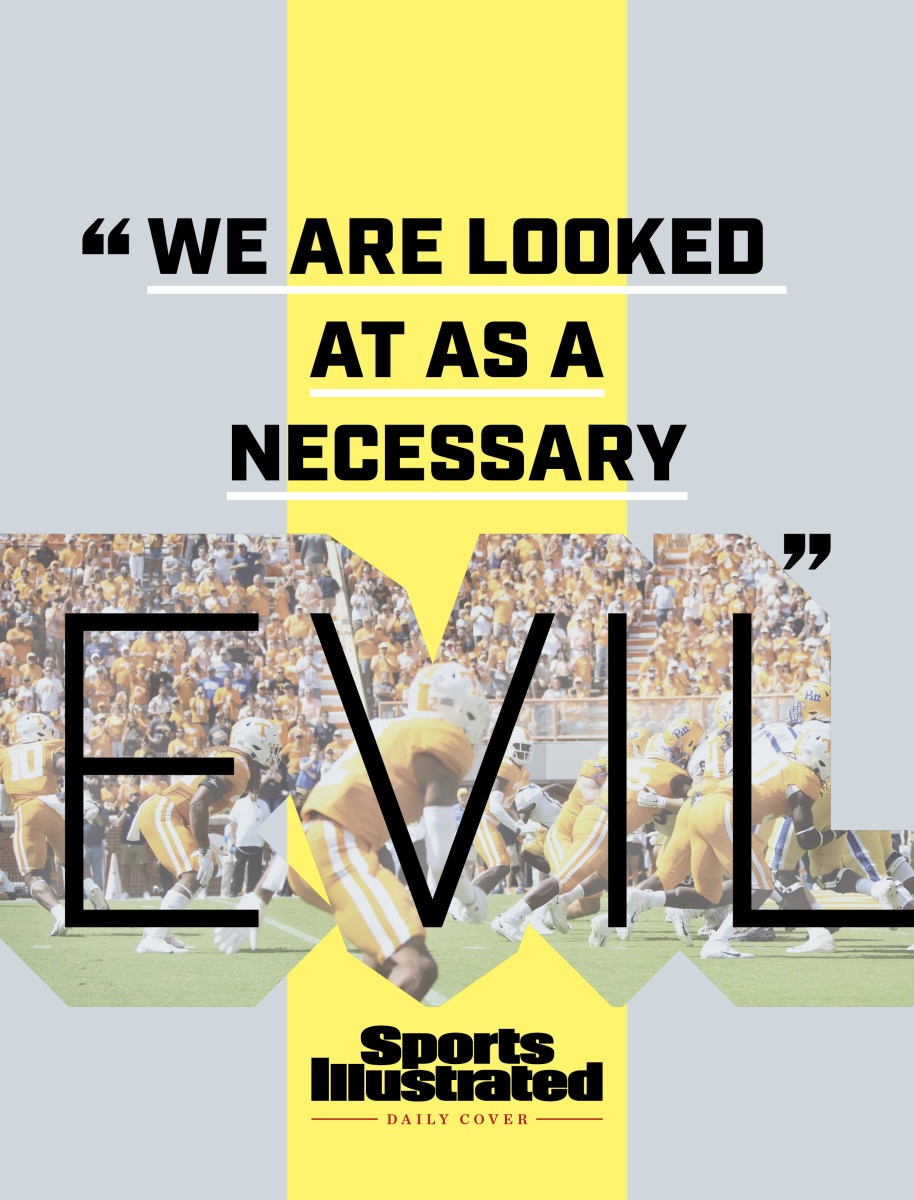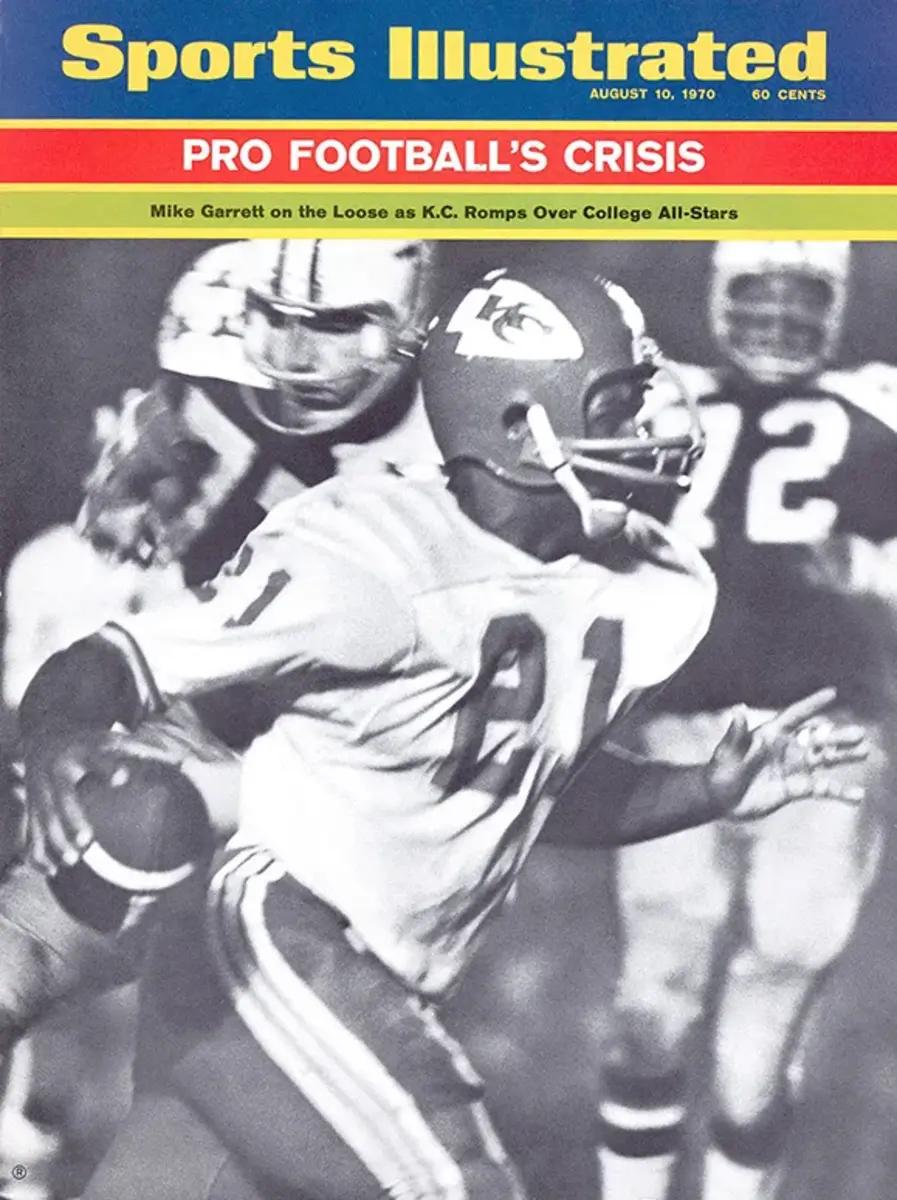SI:AM | Barcelona’s Dire Budget Crunch
Good morning, I’m Dan Gartland. I’ve been thinking about Rodolfo Castro’s phone all morning.
In today’s SI:AM:
🏈 Inside the world of NIL collectives
If you're reading this on SI.com, you can sign up to get this free newsletter in your inbox each weekday at SI.com/newsletters.
Crisis in Catalonia
With La Liga’s season set to get underway this weekend, Barcelona is in (financial) shambles.
The Catalan giants, one of the most famous soccer clubs in the world—one of the most famous sports teams in the world—are in dire financial straits and left scrambling to get everything in order before the Spanish season opener against Rayo Vallecano on Saturday.
Last August, club president Joan Laporta revealed that Barcelona was $1.6 billion in debt. Billion with a capital B! And, to make matters worse, the club owed more in player salaries than its annual income. That’s why Lionel Messi left for Paris Saint-Germain. The club couldn’t sign him to a contract while also abiding by La Liga’s financial fair play rules designed to keep clubs from running up debts.
The current problem facing Barcelona is similar. The club has been active during the summer transfer window, spending more than $140 million combined to sign Robert Lewandowski from Bayern Munich, Raphinha from Leeds United and Jules Koundé from Sevilla. It also signed Andreas Christensen and Franck Kessie on free transfers and re-signed Ousmane Dembélé and Sergi Roberto after their previous deals expired. All seven players must be registered with La Liga before the transfer window closes on Sept. 1, but the pressure is on to register them before Saturday’s opener.
In order for that to happen, Barcelona must satisfy certain financial requirements—and that’s the big problem. To raise money, the cash-strapped club has activated a series of “economic levers.” If that sounds like pulling a big handle and watching money come tumbling out, that’s because it basically is. It’s just a dramatic way of saying that the club has sold assets. In activating the first three levers, it sold 49.5% of its media production division, Barça Studios, and 25% of its La Liga television rights. The club activated the fourth lever yesterday, reportedly selling another 24.5% of Barca Studios to raise €100 million. But it still needs to raise a further €60 million to satisfy La Liga’s requirements.
That brings us to the strange case of Frenkie de Jong. A month ago, Manchester United agreed to pay Barcelona a transfer fee of €75 million (potentially rising to €85 million) to sign de Jong, a 25-year-old Dutch midfielder who blossomed under current United manager Erik ten Hag at Ajax. If the deal went through, Barcelona would have enough money to register its new signings. But United has its own problems and so de Jong has refused to sign with the English club. (Chelsea is also rumored to be interested in signing him.)
Barcelona may have found another way to cut costs involving de Jong, though. The club has reportedly informed him that his current contract (which was signed under Barcelona’s previous leadership) may have involved criminality and could be subject to legal action. The club wants de Jong, who is owed €18 million in deferred payments after accepting a pay cut during the height of the pandemic, to nullify his contract and revert to the terms of his first contract, which was signed in 2019.
Telling a player that he could find himself in legal trouble if he doesn’t take a pay cut is pretty shady, but Barcelona has managed to convince at least one other player to accept a lower salary without any underhanded maneuvers. For the second straight year, Gerard Piqué has reportedly accepted a pay cut to help make the numbers work out in the club’s favor.
But how did Barcelona get in this position in the first place? It’s a question Jonathan Wilson explored in depth in March 2021. There isn’t one answer, of course, but ill-fated decisions on the transfer market are the biggest culprit. The club bought players for more than what they were subsequently sold for and bought players who never contributed.
And then there’s the Neymar move. He was sold to PSG for €222 million in 2017, which Wilson called an “embarrassment”:
Neymar’s move was finalized on Aug. 3. That gave Barcelona four weeks until the transfer deadline. In retrospect it probably should have bided its time and made an informed decision, but, instead, it rushed through the signing of Borussia Dortmund’s rising French star Ousmane Dembélé for €135 million on Aug. 25. It was as though it felt it had to spend big, that it had to do something to assert itself after the embarrassment of losing Neymar, just as it had by embarking on a misguided spree after losing [Luis] Figo.
Dembélé is a good player (he led La Liga with 13 assists last season) but he’s often injured and hasn’t proven himself to be comparable to Neymar. And, when Dembélé struggled in his first season at the club, Barcelona went out and paid €145 million to sign Philippe Coutinho from Liverpool. That’s €280 million to try to replace a player sold for €222 million. It got even worse when Coutinho was sold to Aston Villa this year for a mere €17 million.
While Laporta continues to insist that everything is fine, it’s clear to everyone that it isn’t. To avoid a lost season, the club has been forced into a firesale to raise money it doesn’t have to bring in new players it can’t yet register while also owing returning players back pay and attempting to convince them to forgo it. Barcelona has basically been lighting money on fire for years, and it’s finally paying the price.
The best of Sports Illustrated

In today’s Daily Cover, Ross Dellenger dives deep into the world of NIL collectives, the organizations that have up-ended college recruiting:
According to those with knowledge of player contracts, collectives at the elite Power 5 programs have developed a baseline of about $50,000 per football player a year. The price tag for elite recruits is often at least $100,000 in NIL salary, says LSU booster and Baton Rouge attorney Gordon McKernan, who himself will pay $500,000 in NIL deals this year.
Chris Mannix and Howard Beck discussed whether they think Kevin Durant’s relationship with the Nets is beyond repair after this week’s news. … On the newest episode of SI Weekly John Gonzalez talks with Pat Forde about UCLA and USC’s move to the Big Ten. … Forde also wrote about how the Big Ten’s reported breakup with ESPN is indicative of the changing college football landscape. … Conor Orr asked three NFL agents to help project what the next crop of big receiver contracts will look like.
Around the sports world
A judge ruled against LIV Golf players who filed a lawsuit seeking to play in the FedEx Cup playoffs. … After a meeting with Lakers management, LeBron James and new coach Darvin Ham reportedly agreed that Anthony Davis will be the focal point of the team’s offense. … Red Sox ace Chris Sale is out for the season after breaking his wrist in a bicycle accident. … USC boosters are forming an NIL collective to pay players—against the school’s wishes. … Cardinals pitcher Miles Mikolas became the first player in MLB history to give up 10 runs on 14 hits in less than three innings of work.
The top five...
… things I saw yesterday:
5. Case Keenum’s undercover mission at Bills camp.
4. Shohei Ohtani’s night: six shutout innings and a home run.
3. This ridiculous goal by a 12-year-old soccer player in Brazil.
2. The awesome display of sportsmanship after a hit-by-pitch at the Little League World Series.
1. Rodolfo Castro’s phone falling out of his pocket during an MLB game.
SIQ
On this day in 1977, the Phillies and Expos played a doubleheader that featured rain delays in both games. The second game didn’t end until 3:23 a.m. But incredibly, that isn’t the longest doubleheader (including rain delays) in MLB history. How long did the record-setting twin bill take to play?
- 10 hours
- 11 hours
- 12 hours
- 13 hours
Yesterday’s SIQ: Which of the following cities has Gretzky not said was a contender to land him when he was traded to the Kings in 1988?
- Detroit
- Boston
- Philadelphia
- New York
Answer: Boston.
Gretzky had dismissed a move to the Canucks earlier in the summer. During an appearance on the Spittin’ Chiclets podcast earlier this year, Gretzky said that the morning after the Oilers won the 1988 Stanley Cup, Vancouver businessman Nelson Skalbania called Gretzky with an offer: Skalbania, who previously owned the Flames, would buy a stake in the Canucks and give Gretzky a 25% ownership stake in addition to his salary.
“Nelson, I just finished playing hockey six hours ago; I’m too tired. I’ll call you later,” Gretzky recalled telling him.
But it was clear the Oilers were preparing to trade Gretzky. It was a situation that plays out all the time today. The star player had only one year left on his contract and so his current team, rather than see him walk in free agency, was determined to receive something of value on the way out the door. Gretzky was able to control where he was traded by providing a short list of teams he’d be willing to sign an extension with: the Kings, Rangers, Red Wings and Flyers.
At the time, everyone thought he accepted the trade to the Kings because his wife, Janet, was an actress. But Gretzky said in 2014 that Janet actually preferred Detroit, and it was his dad who angled for the move to Los Angeles.
From the Vault: Aug. 10, 1970

The 1970 preseason was a crucial juncture for the young NFL Players Association. The union, which had only become independent from the Teamsters two years earlier, had gone on strike on July 3, 1970. As the work stoppage approached the one month mark, The New York Times called it “the most serious strike in the history of American sports.”
The biggest test of the strike came at the end of July, when it threatened to disrupt the annual College All-Star Game. The Chiefs were scheduled to face the rookies composing the All-Star team on July 31 at Soldier Field, but, as Joe Jares wrote, the players didn’t view participating in the game as crossing the picket line.
While their colleagues were out on strike, they justified playing because a) the All-Star Game is really an extension of last season, an honor due to the world champions, b) the game was for charity, and c) they wouldn’t gain an advantage over the idle teams because, as Jim Tyrer said, “One week of practice isn’t going to mean anything when the championship game is played in January.”
(The rookies on the All-Star team weren’t eligible to join the union until after their third regular season game.)
Meanwhile, players from the other 25 NFL teams stood firmly behind the strike, leading to speculation that the All-Star Game would be the only NFL action of the year—thus the headline on Jares’s story: “The One-Night Season.”
But those fears were assuaged when, on Aug. 3, the owners and players reached an agreement to end the strike and all the preseason to proceed as planned.
Check out more of SI’s archives and historic images at vault.si.com.
Sports Illustrated may receive compensation for some links to products and services on this website.
